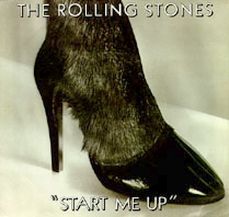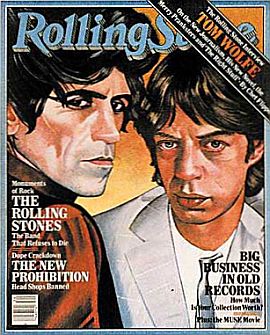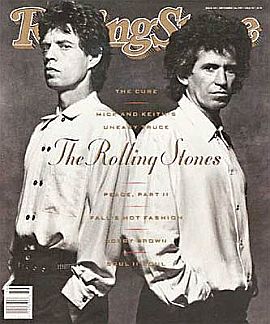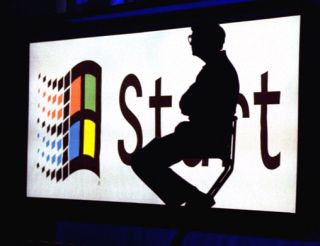
Bill Gates silhouetted against the “start” button during a video portion of the Windows 95 launch at Microsoft in Redmond, Washington, August 1995. AP photo.
As the story goes, it was Gates’ idea to use the song, as the tune dovetailed nicely with the prominent “start button” feature that appeared on the Windows computer screen. Initially it was rumored that Gates paid something in the neighborhood of $10-to-$14 million to the Stones to use their song. The actual amount was much lower, and would end up at around $3 million after negotiations. The earlier figures, which appeared in the UK press, according to some accounts, may have been purposely rumored by the Stones to boost their musical worth.
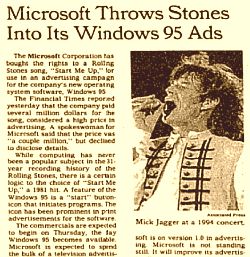
New York Times story of August 18, 1995 on the use of 'Start Me Up" in Windows 95 ad campaign.
But Jagger’s ploy didn’t dissuade Gates — at least according to legend. Whatever amount Jagger had suggested, Gates at least agreed to continue talking about it.
Then came longer negotiations between the Stones and Microsoft’s marketing people and their advertising agency, Wieden & Kennedy, regarding the details on rights and usage. But the deal did get made. (For one detailed account on the deal and negotiations see, Brad Chase, “The Windows 95 ‘Start Me Up’ Story.”)
Once the song was wedded to the Microsoft campaign and its TV spot, most who heard and/or saw it agreed it was a most effective piece of commercial persuasion. “The power-guitar chords are unmistakably familiar, imprinted on us through decades of party time,” wrote Newsweek’s Stephen Levy describing the opening bars of “Start Me Up” in his September 1995 piece on the Windows launch. He called the tune’s use by Microsoft an attempt to “anthemize” the Windows 95 operating system. “The purchase of that classic hook,” Levy wrote, “symbolizes the brilliant way that Microsoft marketing wizards have managed to transmogrify a technological molehill into the Mount McKinley of software…”
In the TV spot itself, as seen above, a series of quick-cut screen shots are shown with children and adults working with computers in various settings as descriptive word titles for those uses flash across the screen in sync with the Stones’ music and the ad’s “start” theme — Start Exploring, Start Discovering, Start Learning, Start Doing, Start Organizing, Start Connecting, Start Managing, Start Creating, Start Playing, Start Moving, and finally, Start Windows 95. As the ad closes with the music still playing, the final screen shot has the Microsoft Windows 95 logo and then the last phrase, “Where do you want to go today?” But the Stones’ music is definitely effective in carrying the message and setting an upbeat tone.
Song History
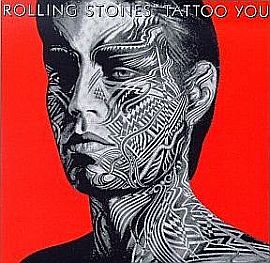
‘Start Me Up’ began as a reggae tune in earlier years, but was turned into a more hard-driving rock sound for use in this ‘Tatto You’ album by 1981. Click for CD.
In any case, “Start Me Up” in 1981 became a Rolling Stones pop hit and also the lead track on their August 1981 album, Tattoo You. The song was also released as a single. In the U.K., it peaked at No. 7. In the U.S., “Start Me Up” spent three weeks during October and November 1981 at No. 2 on the Billboard Hot 100 chart, and in Australia, it went to No. 1. “Start Me Up” thereafter became a popular song for opening the Stones’ live shows, and it has been featured on their live albums as well as most Stones’ compilation albums since its release, and other albums including Rewind (1971-1984), Jump Back, and Forty Licks.
Windows 95
Nearly 15 years after the song’s initial popularity, Bill Gates hit upon the idea of using “Start Me Up” for the Windows 95 launch. Gates happened to meet Mick Jagger at some point and asked him how much it would cost to use the song in advertising. And, as noted earlier, Jagger reportedly replied with some amount in the millions — $10 million by one account — a sum, in any case, that Jagger thought would be outrageously high.Microsoft’s “Start Me Up” campaign was aimed at key groups of Rolling Stones followers — from baby boomers to twenty- somethings… But Gates, reportedly, was undeterred, and turned over the deal making to his marketing people. Still, there were some months of negotiating between Microsoft and the Stones to nail down the song’s use, including talks with the Stones’ agent and financial advisor, Prince Rupert, as well as some direct talks with the Stones in Amsterdam. This was the first time that Mick Jagger and Keith Richards, the group’s songwriters, had sold a song’s use for advertising. Jagger and Richards hold the rights to Rolling Stones’ songs they have written since 1972. However, some of their earlier songs, which they did not hold the rights to, had been used in previous advertising, including one use of the song “Satisfaction” in a Snickers candy bar ad by Mars, Inc. Jagger and Richards were not happy about that incident, but those rights were held by a former manager. Jagger and Richards had generally not been keen on using their material in advertising, but with Gates and Microsoft, they made a deal.
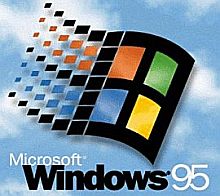
The Microsoft 'Windows 95' logo.
Jay Leno, Too
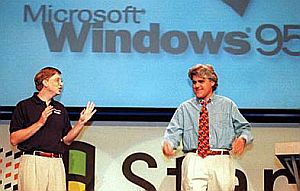
Microsoft’s Bill Gates on stage with Jay Leno at the Windows 95 launch event in Redmond, WA.
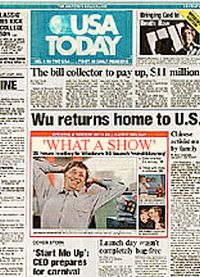
USA Today ran a front-page story on the big ‘Windows 95' show that Bill Gates put on in Redmond, WA.
In London, Microsoft struck a deal with Rupert Murdoch’s News Corporation, owner of The Times of London newspaper, printing 1.5 million copies of a special edition and giving them all way — twice the paper’s normal run of 845,000. Credit for the giveaway was attributed to Microsoft at the top of the front page in a box that read: “Windows 95 Launch — Today The Times is Free Courtesy of Microsoft.” Also across the bottom of the front page was another Microsoft pitch for its new software: “Windows 95. So Good Even The Times Is Complimentary.” Inside the paper, a Microsoft supplement continued the pitch with articles about the new software, as well as advertising from Microsoft and other computer hardware and software companies and retailers.
In New York, Microsoft’s logo colors — orange, yellow and green — were used for a special lighting of the Empire State Building. In Toronto, a 300-foot Windows 95 banner hung from the CN Tower. New York Times reporter Richard Stevenson wrote that the series of Microsoft promotions were “more reminiscent of the recording industry than the computer business, complete with parties and midnight store openings…”
Return on Investment
Bill Gates and Microsoft, meanwhile, were pretty confident that their $300 million in hype would pay off and that the company would recoup its marketing and promotional outlays — and then some.Roughly 100 million com- puter users with earlier versions of Windows would sooner or later upgrade to Windows 95. They knew at the time there were roughly 100 million computer users who had earlier versions of Windows who would sooner or later upgrade to Windows 95. Then there was at least another $250 million of expected sales from add-on software that could be used with Windows 95. And within days of the launch, millions of copies of Windows 95 were sold; more than 40 million in the first year. Windows 95, in its day, soon became the most successful operating system ever produced. And within three years of its introduction — as is the way of the world with computer software — Windows 95 would be followed by new Microsoft software, Windows 98, and subsequent versions, continuing to present times.

Rolling Stones, circa 2005, from left, Charlie Watts, Keith Richards, Mick Jagger, and Ronnie Wood.
See also at this website, “Microsoft & Too Close,” a story on Microsoft’s 2012 TV ad using a dubstep song by Alex Clare titled “Too Close” that helped market Microsoft’s Explorer 9 web browser while also advancing Clare’s career and his song.
Other stories at this website on the Rolling Stones include: “Paint It Black, 1966,” “Stones Gather Dollars, 1989-2008,” and “Shine a Light, 2008.”
Additional stories on music and advertising include: “Big Chill Marketing, 1980s & 1990s,” “Nike & The Beatles,1987-1989,” “Madonna’s Pepsi Ad, 1989,” “Selling Janis Joplin, 1995,” “Sting & Jaguar, 1999-2001,” and “G.E.’s Hot Coal Ad, 2005.” Thanks for visiting — and if you like what you find here, please make a donation to help support the research, writing, and continued publication of this website. Thank you. — Jack Doyle
|
Please Support Thank You |
__________________________________
Date Posted: 23 November 2009
Last Update: 17 January 2023
Comments to: jdoyle@pophistorydig.com
Article Citation:
Jack Doyle, “Start Me Up, 1995,” PopHistoryDig.
com, November 23, 2009.
__________________________________
Sources, Links & Additional Information
“The Media Business; Microsoft Throws Stones Into Its Windows 95 Ads,” New York Times, August 18, 1995.
Denise Gellene, “Microsoft Hopes Rolling Out Stones Will Gather Interest; Firm Wants its Windows 95 Campaign to Strike a Chord in Old and Young,”Los Angeles Times, August 19, 1995, p. D-1.
David Segal, “With Windows 95’s Debut, Microsoft Scales Heights of Hype,” Washington Post, Thursday, August 24, 1995, p. A-14.
Richard W. Stevenson, The Media Business: Advertising; Software Makes Strange Bed- fellows in Britain as Microsoft and Murdoch Team to Push Windows 95,” New York Times, Thursday, August 24, 1995, p. D-6.
Peter H. Lewis, “Snubbed at Windows Party? Log On the Internet,” New York Times, Friday, August 25, 1995 p. D-4.
Steven Levy, “Gimme Software,” Newsweek, September 4, 1995.
Mike Littwin (Baltimore Sun), “Even Mick Jagger, Stones Now Work For Bill Gates,”The Register-Guard (Eugene, Oregon), Thursday, September 7, 1995, p. 6-B.
“Start Me Up, Just Try,” Business Week, Septem-ber 24, 1995.
“Start Me Up,” Wikipedia.org, November 12, 2009.
Ken Polsson, “Chronology of Personal Comput-ers,”@ IslandNet.com.
“Windows 95,” Business Week (Int’l edition), Cover Story, July 17, 1995.
Bob Johnson, “The Launch of Windows 95,” Concentric.net.
JBev, “Hang Fire: Ranking the Stones ’80s Output (Songs 5-1),” JamesBioMagazine, Sep-tember 1st, 2009.
Tony Long, “Aug. 24, 1995: Say Hello to Windows 95,” Wired, August 24, 2007.
